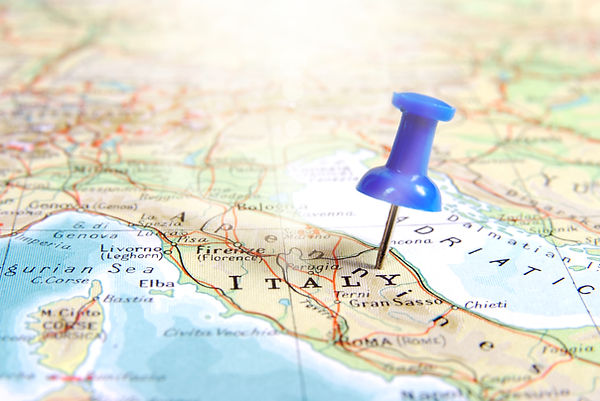Italy’s Mining Heritage
By Dr Marcello de Angelis – Director Italian Subsidiaries
Italy, a country well known for art, architecture and food, also has a vast industrial heritage linked to the mining and processing of minerals. Viewed through the lens of Italy’s long documented mining history, it is possible to understand how Italy is one of the places where culture and art developed in conjunction with the extraction of ore.
The Italian mining history dates back to the early Italian populations, including the Roman Empire, and was revived in the Middle Ages. The first Mining Code was published in Massa Marittima (Tuscany) in the middle of the 14th century, a code that is essentially still in force nowadays all over the world with the exception of a few countries.
Mining sites are the typical combination of industrial, archaeological, cultural, historical and landscape heritage around which social aggregations and communities developed, thus determining the essential conditions for the economic and social growth of the country. The remains and testimonies of over twenty-eight centuries of mining activity along the peninsula provide a considerable wealth of scientific, anthropological and cultural-historical data.
In the early 80s, for political rather than commercial reasons, practically all mines – particularly those that were managed by majority State-controlled entities – were closed or decommissioned. Many sites underwent reclamation to respond to environmental issues and, on the whole, there was no national plan to continue with mining activities.
At present, Italy has a comprehensive mining law which, although dated to 1927, is very similar to countries where mining is one of the major revenue-producing activities. Environmental legislation associated with mineral activities is also well defined and in line with European Union (EU) directives.
The Italian mining law defines minerals in two categories: The first category (minerals of national interest) includes metals, metalloids, graphite, precious stones etc.; the second category (minerals of local interest) includes peat, building and dimension stones, silica sands, quartz, and bentonite. Mineral exploration and mining is permitted for individuals or companies that submit a request for an exploration or a mining licence.
Over the last decade mineral activity in Italy has undergone a resurgence: a number of companies, mainly from Australia, have recognised the potential to develop old mining districts in the light of new concepts and technologies.
This change is seen favourably by the Italian government and several permits have been granted for a number of commodities, most of which include the so-called Critical Raw Materials (CRM) defined by EU directives and aimed at promoting mineral extraction and processing within the member States in order to lessen dependence from other countries.
Italy’s Government is strongly in favour of the EU’s Critical Raw Material Act (CRMA) having called for the “reopening mines or creating new mines” to revive Italy’s strong mining legacy. The Government is open to reform the legislation to create a supportive environment for producing CRMs domestically, boosting economic self-resilience and energy transition. Altamin is a fast mover in this space, having been active in restarting Italy’s long dormant but prospective mineral districts since 2015

“We are assessing the country’s needs and also the potential and
opportunities for producing critical raw materials in Italy. Producing at home
what we now import from Congo, China and Asia is important.”
Adolfo Urso, Italian Minister for Enterprise in a speech on CRMA, 2023
Collaboration with Universities
Ongoing
01.
University of Turin
“Gorno mining district (Southern Alps): ore mineral precipitation and multiphase diagenetic evolution.”
The main goal of the work is to constrain the ore-forming conditions in the Gorno district and to characterize the metal zonation in the ore-deposits.
Dr. Michele Andrea Giorno – PhD

02.
University of Naples
Punta Corna: Hyperspectral and multispectral remote sensing mineral mapping”
The study is focused on an integrated satellite-ground based mapping approach using multiple sources of spectral data with different spectral resolution, based on hyperspectral and multispectral imagery, for mapping the spatial distribution of the hydrothermal alteration associated with the mineralized veins.
Drs. Rita Chirico – PhD
“Gorno: New approaches to the exploration and evaluation of Zn-Pb sulphide and non-sulphide ores”
Using direct observations (Underground outcrops and drillcore) and indirect analysis (geochemical database) elaborate a 3D model of oxidized bodies in order to determine the spatial distribution of non sulphides mineralisation.
BSc Dr. Silvia Gioiello – Master Degree thesis

03.
University of Milan (UNIMI) and
University of Milan-Bicocca (UNIMIB)
Punta Corna: “Study of the distribution of precious and associated critical metals within active and abandoned mines as a tool to implement their primary and secondary recovery”
The project focuses on the distribution, mineralogy and geochemistry of Critical Metals (e.g. Ge, Ga, Co...) within EU mines aimed to their potential recovery as main product or by-product. The main purpose is to determine which mineralogical phases host these Critical Metals, and assess their behaviour during flotation.
Post Doc – Micol Bussolesi

Completed
01.
Politecnico of Turin
Gorno: “Comminution Effects on Mineral Grade Distribution:
3 The Case of an MVT Lead-Zinc Ore Deposit”
Gabriele Baldassare – Master Degree Thesis

02.
University of Milan-Bicocca (UNIMIB)
Punta Corna:
“CARATTERIZZAZIONE DELLE MINERALIZZAZIONI
A COBALTO NEL COMUNE DI USSEGLIO (TO)”
- Simone Orizio
– Master Degree thesis

03.
University of Naples
Gorno: “The Gorno Mississippi Valley-type (MVT) ore deposit (Bergamo): Characterization of the Zn “oxide-type” mineralization”
- Federica Lupone – Master degree thesIs
Gorno: “From Alpine-type sulfides to nonsulfides in the
Gorno Zn Project (Bergamo, Italy)”
Article: Mineralium Deposita (2020)
– Mondillo et Al

04.
University of Turin
Gorno: “Geological and structural characterization of the Vedra Valley Zn-Pb-Ag sulfide ore (Polymetallic Gorno Mining District, northern Italy)” - Federica Lupone – Master degree thesis
The thesis work consisted of the geological-structural survey of the Val Vedra area of the Gorno mining district, both on the surface and underground.
This was followed by the interpretation of the data in order to study the structures associated with the alpine and pre-alpine
deformation of the Triassic successions and the ore bodies associated with them.
Giulia Domenighini – Master degree thesis

